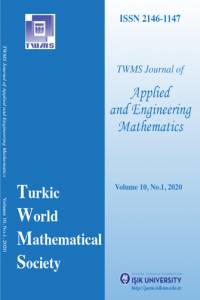ON THE SOLUTION APPROACHES OF THE BAND COLLOCATION PROBLEM
Band Collocation Problem, Dense Wavelength Division Multiplexing, Meta- heuristic Algorithms,
___
- Babayev, D. A., Bell, G. I. and Nuriyev, U. G., (2009), The Bandpass Problem: Combinatorial Optimization and Library of Problems, Journal of Combinatorial Optimization, 18, pp. 151-172.
- Chen, Z. Z. and Wang, L., (2012), An improved approximation algorithm for the bandpass-2 prob- lem, In Proceedings of the 6th Annual International Conference on Combinatorial Optimization and Applications (COCOA 2012), LNCS, 7402, 185-196.
- Dorigo, M., (1992), Optimization, Learning and Natural Algorithms, PhD thesis, Politecnico di Mi- lano.
- Gen M., (2006), Genetic Algorithms and Their Applications, in Springer Handbook of Engineering Statistics (eds. P. Hoang), pp. 749-773.
- Goralski, W. J., (1997), SONET, a Guide to Synchronous Optical Networks, McGraw-Hill, New York. [6] Gursoy, A., Tekin, A., Keserlioglu, S., Kutucu, H., Kurt M. and Nuriyev, U., (2017), An improved binary integer programming model of the Band Collocation problem, Journal of Modern Technology and Engineering, 2(1), pp. 34-42.
- Holland, J. H., (1975), Adaptation in Natural and Artificial Systems, University of Michigan Press.
- Huang, L., Tong, W., Goebel, R., Liu, T. and Lin, G., (2015), A 0.5358-Approximation for Bandpass-2, Journal of Combinatorial Optimization, 30, pp. 612-626.
- Kennedy, J. and Eberhart, R. C., (1985), Particle swarm optimization. In Proceedings of the IEEE International Conference on Neural Networks, 4, pp. 1942-1948.
- Kirkpatrick, S., Gelatt Jr, C.D. and Vecchi, M.P., (1983), Optimization by Simulated Annealing, Science, 220, pp. 671-680.
- Laguna, M., Sanchez-Oro, J., Marti, R. and Duarte, A., (2015), Scatter Search for the Bandpass Problem, 27th European Conference on Operational Research, July.
- Li, Z. and Lin, G., (2011), The Three Column Bandpass Problem is Solvable in Linear Time, Theor. Comput. Sci., 412, pp. 281-299.
- Nuriyev, U., Kutucu, H., Kurt, M. and Gursoy, A., (2015), The Band Collocation Problem in Telecom- munication Networks, Book of Abstracts of the 5th International Conference on Control and Opti- mization with Industrial Applications, pp. 362-365, Baku, Azerbaijan, August 27-29.
- Nuriyev, U., Kurt, M., Kutucu, H. and Gursoy A., (2015), The Band Collocation Problem and Its Combinatorial Model, Abstract Book of the International Conference Matematical and Computational Modelling in Science and Technology, pp. 140-142, Izmir, Turkey, August 02-07.
- Nuriyev U., Kurt M., Kutucu, H. and Gursoy, A., (2015), Band Collocation Problem Online Library (BCPLib): http://fen.ege.edu.tr/ arifgursoy/bps/, (2015) (LAD: December 6, 2017).
- Nuriyeva, F., (2016), On a generalized sequential partially covering problem, Appl. Comput. Math., 15(2), pp. 239-242.
- Ramaswami, R., Sivarajan, K. and Sasaki, G., (1998), Optical Networks: A Practical Perspective. Morgan Kaufmann, San Francisco.
- Tong, W., Goebel, R., Liu, T. and Lin, G., (2014) Approximation Algorithms for the Maximum Multiple RNA Interaction Problem, Theoretical Computer Science, 556, pp. 63–70.
- ISSN: 2146-1147
- Başlangıç: 2010
- Yayıncı: Turkic World Mathematical Society
V. LOKESHA, M. MANJUNATH, K. M. DEVENDRAİAH
K. N. PRAKASHA, K. KİRAN, S. RAKSHİTH
M. Z. SARIKAYA, H. BUDAK, H. USTA
M. JAVAİD, A RAHEEM, M. ABBAS, J. CAO
M. ÖZKAN, A. DERTLİ, Y. CENGELLENMİS
